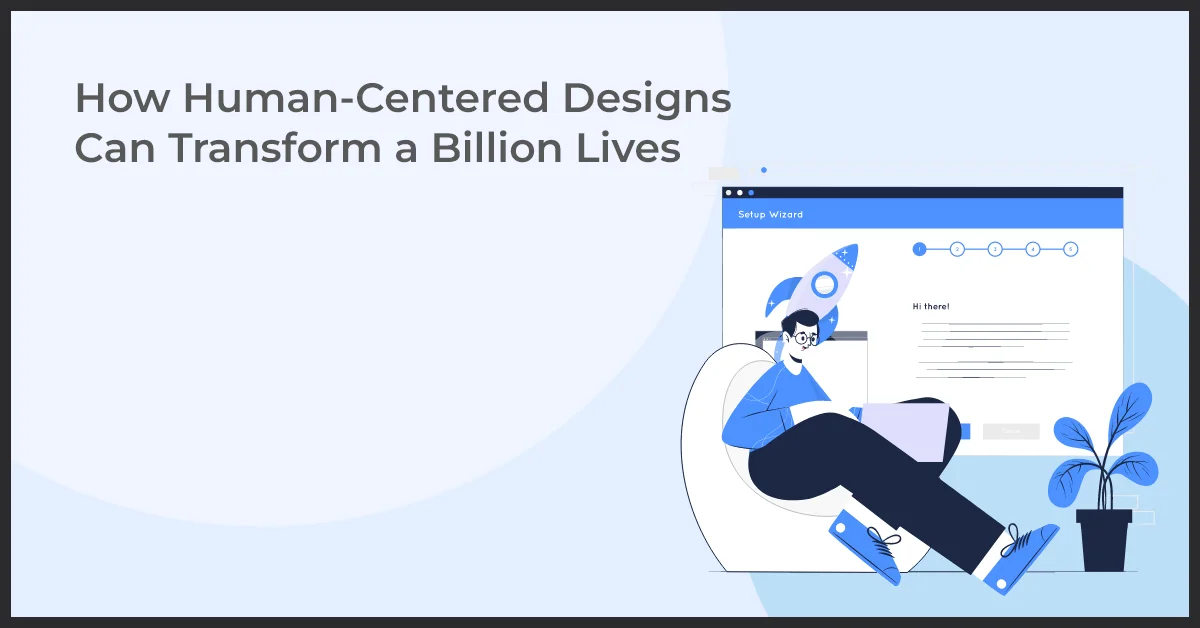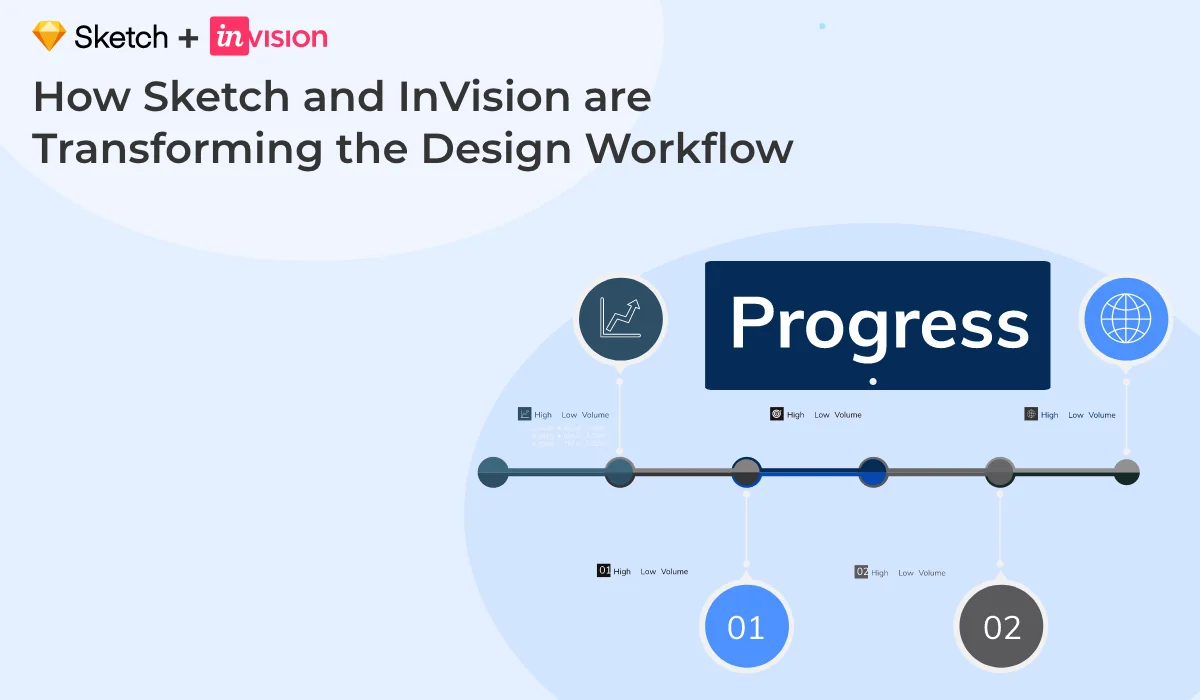The Power of Human-Centered Design to Transform Billions of Lives

Published on: May 30, 2022
Updated on: February 03, 2025
3867 Views
- Design
14 min read
The growth of the internet is well documented and by the end of the day, 6,00,000 new users would have gone online for the first time in their lives. While people in the urban and developed parts of the world take the internet and access to knowledge for granted, there are regions around the world where millions of people are still waiting to get their first taste of access to digital information.
In the last decade, the growth of internet accessibility has been phenomenal. From 1.8 billion users in 2011, we now have approximately five billion internet users in 2022 (Statista).
It is interesting to note that most of the new users haven’t logged in from Western Europe, North America, and China, who are the global leaders in terms of internet penetration.
However, they have come from places as far as Uganda, India, Argentina, Morocco, and Ethiopia. As the internet reaches the furthest corners of the globe and millions of new users log in every month, it will be important for designers to focus on human-centered Designs.
What Is a Human-Centered Design?
It is a design philosophy that is focused on addressing the core needs of users who face problems. Unlike other design philosophies, human-centered design aims to understand the perspective of users and create solutions that truly empower them.
For instance, if the design team is designing an app or website for the senior population, they would focus on the iconography and typography that is easier for people with weakening eyesight to understand and take intended actions.
Modern-day web and application design draws inspiration from this design philosophy to take technology to the masses. The idea is to reach out to the next set of users who are going online as the internet reaches the remotest islands and countryside.
This is an ongoing information revolution in different parts of the world to connect and empower people using the internet and human-centered design is playing a key role here.
Importance of Human-Centered Design in today's world
In our ever-evolving and rapidly advancing world, where technology is shaping the way we live, work, and interact, it has become increasingly crucial to prioritize the human element in the design process. Human-Centered Design allows us to create solutions that truly meet the needs and desires of the people they are intended for.
By adopting an HCD approach, designers can avoid the pitfalls of creating products or services that don't resonate with users, wasting time, resources, and effort. It enables them to develop solutions that are intuitive, user-friendly, and capable of providing meaningful experiences.
Furthermore, Human-Centered Design fosters empathy and inclusivity, benefiting diverse audiences by considering their unique challenges and requirements. It ensures that accessibility, usability, and user satisfaction are at the forefront, resulting in designs that are not only functional but also enjoyable to use.
In a world where user expectations are constantly evolving, businesses and organizations that embrace Human-Centered Design are more likely to stay relevant, gain a competitive edge, and build lasting customer loyalty. By genuinely understanding and addressing the needs and aspirations of their target audience, they can develop products and services that foster meaningful connections and deliver exceptional value.
Overall, Human-Centered Design has emerged as a powerful tool for innovation and problem-solving in today's world. By keeping people at the heart of the design process, we can create solutions that truly make a positive impact on individuals, communities, and society as a whole.
Understanding Design Thinking
Design thinking is a problem-solving approach that puts humans at the core of the design process. It is a creative and iterative process that emphasizes empathy, collaboration, and experimentation. By understanding the needs and desires of users, design thinking aims to create innovative solutions that truly resonate with people.
A. Overview of Design Thinking
Design thinking involves a series of steps that guide designers in developing solutions. These steps typically include empathizing with users, defining the problem, ideating potential solutions, prototyping ideas, and testing them with users to gather feedback. This cyclical process encourages designers to continuously iterate and refine their ideas.
B. Key Principles and Elements of Design Thinking
Design thinking follows a set of principles and incorporates various elements to ensure effective problem-solving. One of the key principles is to focus on the user by deeply understanding their needs, motivations, and behaviors. This helps designers create solutions that are meaningful and valuable to users.
Design thinking also emphasizes collaboration and interdisciplinary teams. By bringing together individuals with different expertise, perspectives, and backgrounds, design thinking enables a holistic approach to problem-solving. This collaborative environment fosters creativity and encourages diverse ideas.
Another important element of design thinking is prototyping. Prototyping allows designers to bring their ideas to life in a tangible form. It enables users to interact with the design and provide valuable feedback. This iterative feedback loop helps designers refine their solutions and create a better user experience.
Furthermore, design thinking encourages a mindset of experimentation and risk-taking. It encourages designers to embrace failure as an opportunity for learning and growth. This mindset allows for innovative ideas to emerge and for designers to push the boundaries of conventional thinking.
Here is how human-centered designs can transform billions of lives:
1. Overcoming Accessibility Issues
Healthcare infrastructure, social security, and access to education in developing and under-developed regions of the world aren’t the same as in developed countries.
A higher percentage of the population has disabilities in these parts of the world. Along with the physical disabilities, there are also several other issues with gender inequality, posttraumatic stress disorder due to war, and ethnic conflicts.
Here it becomes important for designers to make websites that are more accessible for the end-users. The design philosophy that is successful in developed parts of the world might not yield the same success in developing and under-developed regions.
2. Designing for Accessibility Issues
- Research on the kind of accessibility issues people in a geography and region face and take these into account while designing the UI.
- Listen to the NGOs and other organizations that are working closely with differently-abled people and understand the demographics of the population to design UIs that are better accessible.
- Gender inequality is common in several parts of the world and the design language used shouldn’t hurt the beliefs of society. A designer’s job isn’t to preach but to make information widely accessible and acceptable.
3. Breaking the Cultural Barrier
In its early days, the internet evolved as an English-only medium. As its usage spread to the developed parts of the world, we saw the emergence of several other languages.
The next billion internet users are expected to join from the developed and developing parts of the world including India, Sub-Saharan Africa, Indonesia, South America to name a few.
The language barrier has been gradually broken with websites running in more than a hundred languages. However, designers have a bigger challenge of transcending the cultural, religious, and ethnic barriers.
The design language that is widely accepted in one part of the world might amount to blasphemy in another.
4. Strategies to Overcome Cultural Barrier
- English isn’t the first language everywhere in the world and designers shouldn’t expect their target audience to have knowledge of the language and behave as the English-speaking audience does.
- Study the target audience and get acquainted with their local culture, art, design, and religious beliefs dominating their lifestyle. Draw inspiration from their way of life and use the easily identifiable symbols and elements in the design.
- Respect people’s beliefs irrespective of how irrational they may seem in the developed regions of the world. Keep in mind cultural nuances and avoid adding derogatory or offensive elements in the design.
5. Getting over the ‘iPhone Mindset’
Yes, the Apple iPhone is the ultimate smartphone in the world and a symbol of pride for many but the majority of the users in developing parts of the world browse the internet on low-priced and low-specs devices.
For instance, iOS devices command more than 40% of the market share in the United States whereas in India which has the second-largest internet userbase in the world after China iOS devices have just over 3% of the market share.
iPhone here is a metaphor to represent premium computing and communication devices. As a designer, it is important to focus on reach and not sacrifice it for all the gloss of a website or application –
#Tips to Overcome iPhone Mindset
- Always think of the low-spec smartphones, laptops, etc. while designing websites and apps. If it is good for these devices, it would also deliver
- Integrate maximum options when it comes to payment methods and research on the most popular online payment methods in the target geography
- Think of the target audience as first-time internet users and ensure they aren’t intimated by your designs
- Keep an eye on the income levels and per capita GDP in the geographies where your users are. A $1 app may seem like peanuts in the developed parts of the world, but the same money can buy daily meals for a family in several countries.
6. Breaking The Low Speed ‘No Internet’ Barrier
Did you know there are more than a billion people who live in areas with no access to the internet? Though most of us in the developed world tend to take internet access for granted, the same isn’t true the world over.
Internet access remains a luxury in many parts of the world to this day. People are constantly moving between areas of internet coverage and internet shadow areas.
In many countries, internet access is an urban phenomenon where mobile internet is still a dream for people in the countryside. Even in the urban areas data prices are exorbitantly high and internet speeds are unreliable.
Users in several countries still have to manage their internet quota efficiently. Designers must accept these challenges to overcome the barrier.
#How To Break the No Internet Barrier?
- Design websites and apps with offline capabilities. Your designs should incorporate features that can be used when the user has no or limited access to the internet.
- Integrate visual elements in the design that help users identify when apps and websites are switching between online and offline modes
- Let users download files for offline and future use. Clearly state the size of the files for them to make a choice considering the high cost of mobile data when it is available.
- Your UX and UI should seamlessly sync information when users gain internet access to ensure a smoother experience
Human-Centered Design Process
The human-centered design process is a systematic approach that aims to create products and services that meet the needs and desires of users. By placing the users at the center of the design process, organizations can develop solutions that are intuitive, user-friendly, and truly meet the users' requirements.
A. Problem Identification
In this stage, the focus is on understanding the needs and pain points of the users. By identifying these issues, designers can begin to define the problem statement, which will serve as a guide throughout the design process.
- Identifying user needs and pain points: Conducting user interviews, surveys, and observing user behavior can help identify the problems users are facing.
- Defining the problem statement: Once the problems have been identified, designers can define a clear and concise problem statement that outlines the main issues to be addressed.
B. User Research
User research plays a crucial role in the design process as it provides valuable insights into the users' preferences, behaviors, and expectations. By conducting thorough research, designers can gain a better understanding of the target audience and create solutions that cater to their specific needs.
- Importance of user research in the design process: User research helps designers gain empathy, uncover user needs, and validate design decisions.
- Methods and techniques for conducting user research: User research can be done through methods such as interviews, surveys, observation, and usability testing.
- Analyzing and interpreting user research data: Once the research data has been collected, designers need to analyze and interpret the findings to gain meaningful insights.
C. Empathy and Understanding Users
Developing empathy towards users is essential for understanding their behaviors, motivations, and emotions. By putting themselves in the users' shoes, designers can create solutions that resonate with the target audience.
- Developing empathy towards users: Designers can develop empathy by immersing themselves in the users' environment, sharing experiences, and actively listening to their needs.
- Understanding user behaviors, motivations, and emotions: By studying user behaviors, motivations, and emotions, designers can gain insights into the users' needs and tailor their designs accordingly.
D. Ideation and Solution Generation
This stage involves generating creative ideas to solve the identified problems. By brainstorming and encouraging collaboration, designers can explore a wide range of possibilities and come up with innovative solutions.
- Techniques for generating creative ideas: Designers can use techniques such as mind mapping, brainwriting, and SCAMPER to stimulate creativity and generate innovative ideas.
- Collaborative brainstorming sessions: By involving multiple stakeholders in brainstorming sessions, designers can benefit from diverse perspectives and foster a culture of collaboration.
E. Prototyping and Iteration
Prototyping is a crucial step in the design process as it allows designers to transform their ideas into tangible forms. By creating prototypes, designers can test and refine their solutions based on user feedback, leading to better outcomes.
- Importance of prototyping in the design process: Prototyping enables designers to gather feedback, identify flaws, and refine their designs before investing in full-scale production.
- Different prototyping techniques and tools: Designers can use techniques such as paper prototyping, wireframing, and interactive prototypes to create and refine their designs.
- Iterative refinement based on user feedback: By incorporating user feedback, designers can make iterative improvements to their prototypes, ensuring that the final product meets the users' expectations.
F. Usability Testing
Usability testing involves observing and measuring how users interact with a product or service. By conducting effective usability tests, designers can identify usability issues and make necessary adjustments.
- Conducting effective usability tests: Designers can use techniques such as thinking aloud, task-based testing, and eye tracking to evaluate the usability of their designs.
- Analyzing usability test results: By analyzing the results of usability tests, designers can identify usability issues and prioritize improvements.
- Incorporating user feedback into design iterations: Designers should listen to user feedback and make necessary changes to ensure that the final product meets the users' needs and expectations.
Final Thoughts
Billions of users around the world are new to the internet and a billion more are expected to go online in the next five years. Every website and application design should consider their needs, the challenges they face and focus on problem-solving for these users.
The approach behind the Human-Centered Design is one of democratization where new users can become part of the global information ecosystem with ease.
If you are looking for human-centered designs that help you reach the new generation of internet users, Growth Natives can help. We are a forward-looking digital agency and have expertise in designing websites and UI for different regions of the world.
Our expert designers keep an eye on the latest trends and employ an innovative approach to overcome linguistic and cultural barriers.
To know more about human-centered Designs and how they can help your business grow in the remotest corners of the world, get in touch with our team at info@growthnatives.com. Visit our website to know more about our services.



